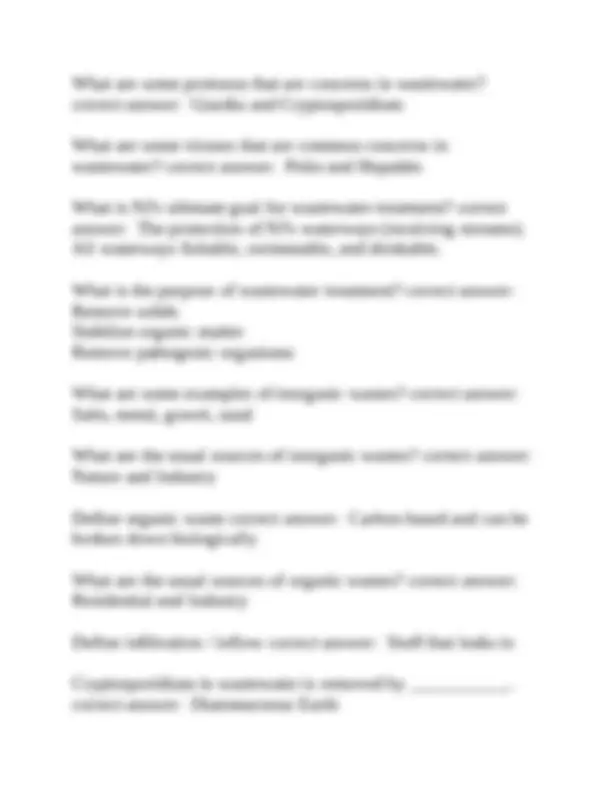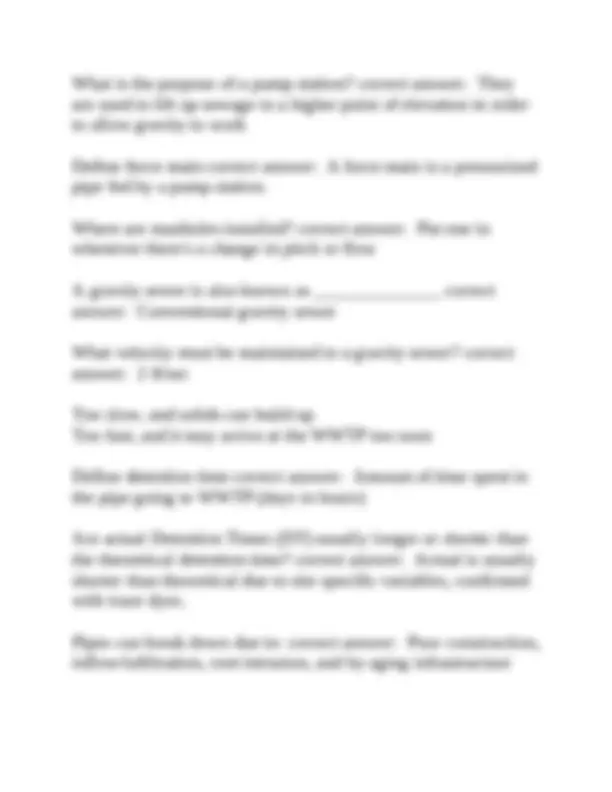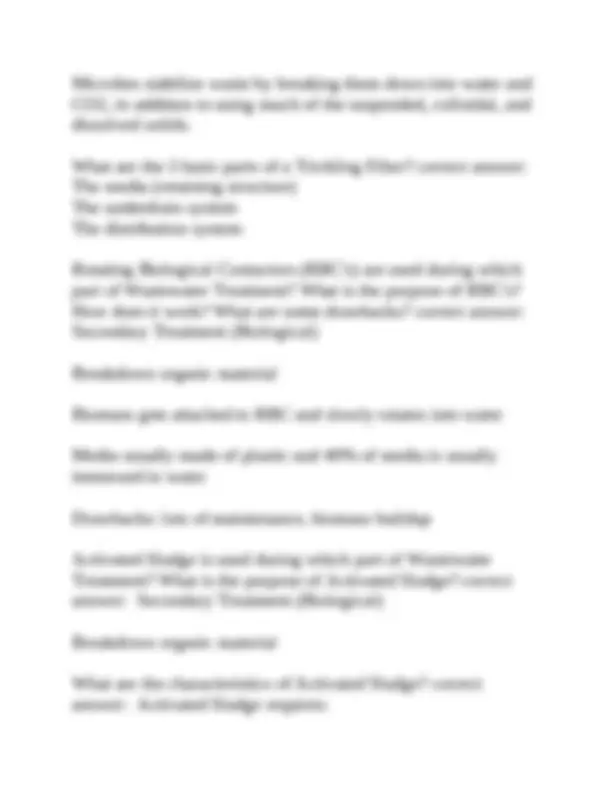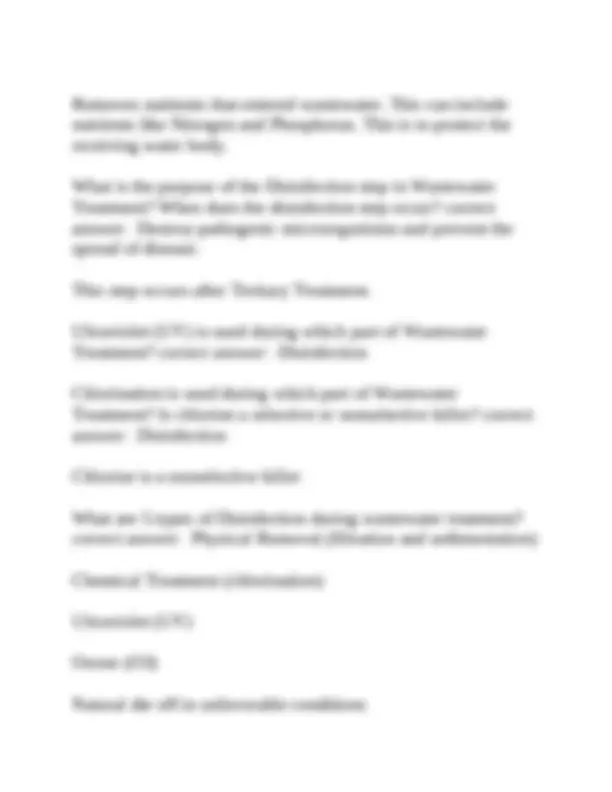











Study with the several resources on Docsity

Earn points by helping other students or get them with a premium plan


Prepare for your exams
Study with the several resources on Docsity

Earn points to download
Earn points by helping other students or get them with a premium plan
Community
Ask the community for help and clear up your study doubts
Discover the best universities in your country according to Docsity users
Free resources
Download our free guides on studying techniques, anxiety management strategies, and thesis advice from Docsity tutors
A comprehensive set of questions and answers related to wastewater treatment processes, covering topics such as preliminary, primary, secondary, and tertiary treatment, disinfection, solids treatment, and common concerns in wastewater. It also explores the purpose of the npdes and njpdes systems, wastewater collection systems, and the role of pump stations and force mains. Valuable for students studying environmental engineering or related fields, offering a structured approach to understanding the key concepts and principles of wastewater treatment.
Typology: Exams
1 / 15

This page cannot be seen from the preview
Don't miss anything!










What are the treatment processes in PRELIMINARY Wastewater Treatment? correct answer: Screening Comminution Grit Removal Pre-Aeration Flow Metering / Sampling What are the treatment processes in PRIMARY Wastewater Treatment? correct answer: Sedimentation / Flotation What are the treatment processes in SECONDARY Wastewater Treatment? correct answer: Biological Treatment (ie activated sludge, trickling filters, rotating biological contactor (RBC)) Sedimentation What are the treatment processes in TERTIARY Wastewater Treatment? correct answer: Filtration Chemical / biological treatment of nutrients Sedimentation (optional) What are the treatment processes in the DISINFECTION step in Wastewater Treatment? correct answer: Chlorination
Ultraviolet Ozone What are the treatment processes in the SOLIDS TREATMENT step in Wastewater Treatment? correct answer: Dewatering Digestion Disposal What are the steps in the Wastewater Treatment Process? correct answer: Preliminary Treatment (screening, comminution, grit removal, pre-aeration, flow metering/sampling) Primary Treatment (sedimentation/flotation) Secondary Treatment (biological treatment, sedimentation) Tertiary Treatment (filtration, chemical/biological treatment of nutrients, sedimentation (optional)) Disinfection (chlorination, ultraviolet, ozone) Solids Treatment (dewatering, digestion, disposal) What are some diseases that are common concerns in wastewater? correct answer: Cholera, dysentery, salmonella, typhoid fever mainly Less commonly, anthrax
What is the purpose of the NPDES and NJPDES system? What are some characteristics of it? correct answer: Purpose is to keep our waterways simmable, fishable, and suitable for recreation. Permit issuance - self sampling/monitoring (facility must monitor waste streams) and compliance monitoring (NJDEP reviews/inspects self-monitoring program). Only regulates Point Sources Establishes Total Maximum Daily Loads (TMDL's) for discharge base on the Water Quality Standards (WQS) Permit conditions are based on the receiving water body. More pristine water bodies have more stringent limits. Name and define the 3 types of wastewater collection systems: correct answer: Sanitary Sewer: waste carried from homes, commercial, and industrial facilities to WWTP Storm Sewer: Storm runoff from streets, buildings, land. Discharged directly to receiving stream untreated. Combine Sewer: All water goes to the same place. When overloaded, sanitary portions may overflow directly into receiving stream.
What is the purpose of a pump station? correct answer: They are used to lift up sewage to a higher point of elevation in order to allow gravity to work Define force main correct answer: A force main is a pressurized pipe fed by a pump station. Where are manholes installed? correct answer: Put one in whenever there's a change in pitch or flow A gravity sewer is also known as ______________ correct answer: Conventional gravity sewer What velocity must be maintained in a gravity sewer? correct answer: 2 ft/sec Too slow, and solids can build up Too fast, and it may arrive at the WWTP too soon Define detention time correct answer: Amount of time spent in the pipe going to WWTP (days to hours) Are actual Detention Times (DT) usually longer or shorter than the theoretical detention time? correct answer: Actual is usually shorter than theoretical due to site specific variables, confirmed with trace dyes. Pipes can break down due to: correct answer: Poor construction, inflow/infiltration, root intrusion, and by aging infrastructure
Grit classifiers use pressure/velocity to remove grit. Pre-Aeration takes place during which part of Wastewater Treatment? What is the purpose of Pre-Aeration? correct answer: Preliminary Treatment Freshen and separate oils and grease. Aids in BOD removal. What is the velocity that must be maintained during sedimentation/flotation? correct answer: 0.03 ft/sec, significantly slower than the 2 ft/sec in the sewer pipes. Sedimentation/Flotation takes place during which part of Wastewater Treatment? What is the purpose of Sedimentation/Flotation? correct answer: Primary Treatment Its purpose is to remove as much material as possible prior to biological treatment. Separation between solids, scums, and water. Detention time is 2-6 hours. What is another name for a sedimentation tanks? correct answer: Clarifier Which sedimentation tanks (clarifiers) handle to the most dense sludge? correct answer: Primary clarifiers, then secondary, then final (tertiary) clarifiers.
How does a sedimentation tank (clarifier) work? correct answer: Solids settle to the bottom of the tank and are either scraped to one end (rectangular tank) or to the middle hopper (circular tank). Solids are pumped from that tank to the solids handling facility. Scrape scum on top. Gray water sent to next step in treatment process (biological treatment). What is the relationship between water temperature and settling rate during sedimentation/flotation? correct answer: Settling rate increases with water temperature Biological Treatment takes place during which part of Wastewater Treatment? What is the purpose of Biological Treatment? correct answer: Secondary Treatment Remove lighter suspended/dissolved solids that exert a strong BOD on receiving waters. What does biological treatment do and what are the 3 main elements of biological treatment? correct answer: Breakdown of organic material via micro-organisms (bacteria). Three main elements are: Food (organic pollutants measured by BOD) Micro-organisms (bacteria that eat pollutants) Oxygen (respiration for bacteria)
Microbes stabilize waste by breaking them down into water and CO2, in addition to using much of the suspended, colloidal, and dissolved solids. What are the 3 basic parts of a Trickling Filter? correct answer: The media (retaining structure) The underdrain system The distribution system Rotating Biological Contactors (RBC's) are used during which part of Wastewater Treatment? What is the purpose of RBC's? How does it work? What are some drawbacks? correct answer: Secondary Treatment (Biological) Breakdown organic material Biomass gets attached to RBC and slowly rotates into water Media usually made of plastic and 40% of media is usually immersed in water Drawbacks: lots of maintenance, biomass buildup Activated Sludge is used during which part of Wastewater Treatment? What is the purpose of Activated Sludge? correct answer: Secondary Treatment (Biological) Breakdown organic material What are the characteristics of Activated Sludge? correct answer: Activated Sludge requires:
aeration tank aeration equipment settling tanks return/waste sludge support equipment It utilizes suspended growth Microbes stabilize waste Microbes are referred to as activated sludge How does Activated Sludge work? correct answer: Wastewater is mixed with Return Activated Sludge (RAS), forming a Mixed Liquor. Mixed Liquor is aerated for a period of time, allowing microbes to feed on available organic matter. Produces stable solids, known as activated sludge. Activated sludge separated from WW by clarification (sedimentation tanks). Settled activated sludge sent to head of aeration tank. Excessive solids removed from system. Define Activated Sludge correct answer: floc or solid formed by microbes
Mixes microbes with food to allow suitable contact time for treatment Aeration can be mechanical or diffused air supply What are some types of aeration equipment, which is used during the Activated Sludge process? correct answer: Mechanical: motor driven agitators. Oxygen is transferred via atmospheric transpiration. Diffused: blower feed systems are most common. Deliver air from blower in a controlled fashion. During the Activated Sludge process, what is the purpose of Settling Tanks (clarifiers)? correct answer: Separate solids (activated sludge) from wastewater Settled solids (microbes) are pumped back to head or aeration tank (Return Activated Sludge (RAS)) or to solids handling facility (Waste Activated Slude (WAS)) Is the Activated Sludge treatment process mostly aerobic or anaerobic? correct answer: Aerobic Enhanced biological treatment is usually done to remove ____________ correct answer: Nitrogen and Phosphorus Chemical/Biological treatment of nutrients takes place during which part of Wastewater Treatment? What is the purpose of this? correct answer: Tertiary Treatment
Removes nutrients that entered wastewater. This can include nutrients like Nitrogen and Phosphorus. This is to protect the receiving water body. What is the purpose of the Disinfection step in Wastewater Treatment? When does the disinfection step occur? correct answer: Destroy pathogenic microorganisms and prevent the spread of disease. This step occurs after Tertiary Treatment. Ultraviolet (UV) is used during which part of Wastewater Treatment? correct answer: Disinfection Chlorination is used during which part of Wastewater Treatment? Is chlorine a selective or nonselective killer? correct answer: Disinfection Chlorine is a nonselective killer What are 5 types of Disinfection during wastewater treatment? correct answer: Physical Removal (filtration and sedimentation) Chemical Treatment (chlorination) Ultraviolet (UV) Ozone (O3) Natural die off in unfavorable conditions